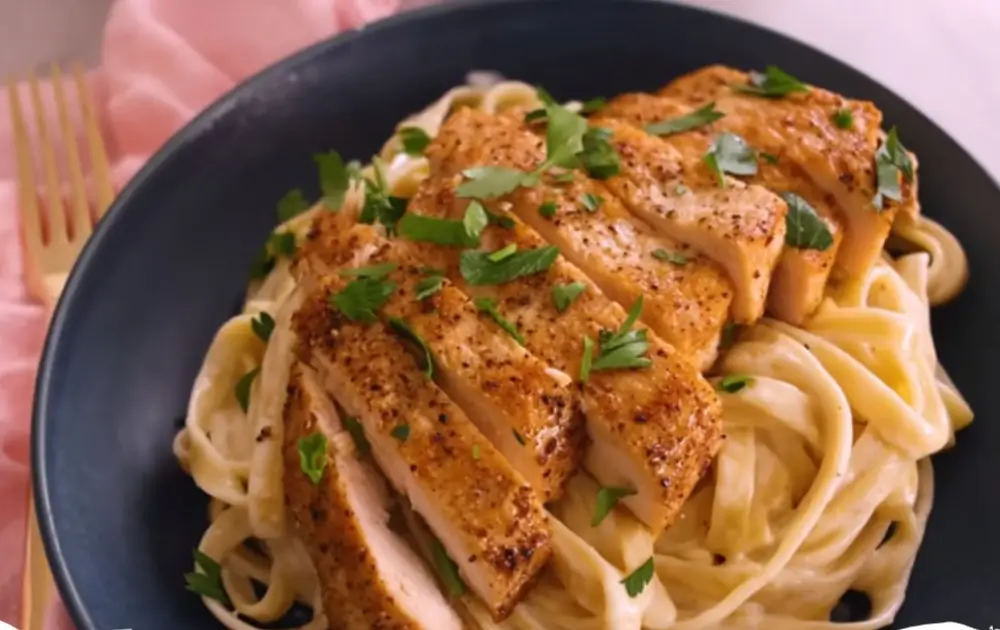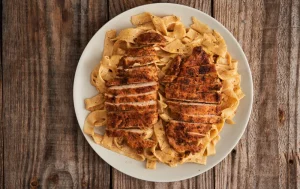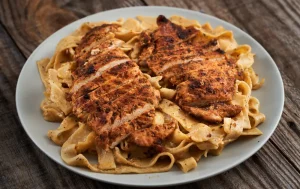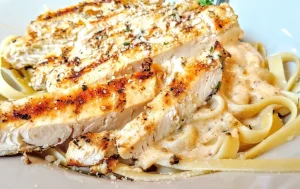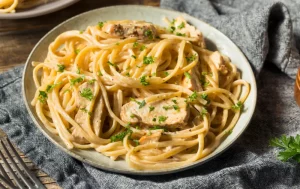Chicken Alfredo stands as a pinnacle of comfort food, cherished by many for its creamy, rich sauce and tender chicken. A dish with roots in Italian cuisine, it has found a warm place in the hearts and kitchens around the globe. This beloved recipe combines succulent chicken, perfectly cooked pasta, and a luxuriously creamy Parmesan cheese sauce.
History and Evolution:
Contrary to popular belief, the original Alfredo sauce was a simple emulsion of butter and Parmesan cheese, created in Rome by Alfredo di Lelio in the early 20th century. It was his way of enticing his pregnant wife back to eating during her nausea. The dish gained international fame when Hollywood stars Douglas Fairbanks and Mary Pickford visited his restaurant and fell in love with this simple yet delicious pasta. Over time, as the recipe traveled, especially to the United States, it evolved, incorporating cream to achieve a richer, thicker consistency, and chicken to add protein and make it a more substantial meal.
Ingredients and Preparation:
At its core, Chicken Alfredo requires few ingredients: pasta (typically fettuccine), chicken breast, heavy cream, Parmesan cheese, butter, garlic, and seasonings. The chicken is usually seasoned, pan-seared, or grilled, then sliced. The sauce is a creamy concoction of butter, heavy cream, and freshly grated Parmesan cheese, often infused with garlic to add depth of flavor. The pasta, ideally fettuccine for its ability to hold the sauce, is tossed with this decadent sauce and topped with slices of chicken.
Variations and Modern Twists:
While purists might argue for the simplicity of the original, Chicken Alfredo has seen numerous variations. Some cooks add vegetables like broccoli, mushrooms, or spinach to introduce texture and color. Others experiment with different cheeses or add a splash of white wine to the sauce for complexity. Low-carb versions swap pasta for zoodles (zucchini noodles), and there are even vegan renditions utilizing plant-based cream and cheese substitutes.
Cultural Impact and Popularity:
Chicken Alfredo is more than just a dish; it’s a cultural phenomenon, especially in American Italian cuisine. Its ease of preparation and versatile nature make it a favorite for home cooks and professional chefs alike. It graces the menu of nearly every Italian restaurant in the U.S. and has become a staple for family dinners, romantic meals, and comfort eating. The dish’s creamy texture, combined with the heartiness of chicken and the robust flavor of Parmesan, offers a satisfying meal that is both comforting and luxurious.
Chicken Alfredo embodies the essence of comfort food with its rich flavors and creamy texture. Its journey from a Roman trattoria to global fame is a testament to the dish’s enduring appeal. Whether you stick to the traditional recipe or venture into modern adaptations, Chicken Alfredo remains a timeless classic that brings warmth and comfort to the dining table.
Nutritional Considerations and Adaptations:
In the landscape of modern cuisine, where health consciousness plays a significant role in meal choices, Chicken Alfredo has seen adaptations that cater to a variety of dietary needs. Whole wheat or gluten-free pasta alternatives can be used to accommodate those with specific dietary restrictions, while the sauce can be made lighter with the use of low-fat cream or milk, though it’s worth noting that these substitutions may alter the classic texture and richness of the dish.
Cooking Techniques:
Achieving the perfect Chicken Alfredo involves mastering a few key cooking techniques. The chicken should be cooked to perfection, retaining its moisture and tenderness. A common method involves searing the chicken breast to lock in juices and then finishing it in the oven. When it comes to the Alfredo sauce, gentle heat is crucial to prevent the dairy components from separating or becoming too thick. The magic happens when the pasta is tossed with the sauce, as it absorbs the flavors and becomes coated in creamy goodness. Some chefs recommend saving a bit of pasta water to adjust the sauce’s consistency, ensuring it clings beautifully to the noodles.
Serving Suggestions:
Presentation plays a significant role in enjoying Chicken Alfredo. A generous sprinkle of freshly grated Parmesan and a touch of cracked black pepper can elevate the dish, while a side of garlic bread or a crisp green salad complements the creamy pasta beautifully, adding textures and flavors that balance the meal. For a truly indulgent experience, a glass of white wine, such as a Chardonnay or Pinot Grigio, pairs wonderfully with the creamy sauce and savory chicken.
Global Appeal:
Despite its Italian roots, Chicken Alfredo has transcended cultural boundaries, finding popularity worldwide. Its basic ingredients—chicken, pasta, and cheese—are universally loved, making it a dish that resonates with diverse palates. International versions might incorporate local ingredients or flavors, further proving the recipe’s versatility and widespread appeal.
The Joy of Homemade:
There’s a special satisfaction in creating Chicken Alfredo from scratch, blending the ingredients with care and watching as they transform into a comforting, indulgent meal. It’s a dish that encourages experimentation, whether in choosing the type of pasta, adjusting the sauce’s creaminess, or adding personal touches with spices or additional ingredients. In the end, Chicken Alfredo is more than just food; it’s an expression of culinary creativity and a testament to the enduring appeal of simple, hearty, and delicious meals.
Interactive Cooking and Social Experiences:
Chicken Alfredo has become a favorite for interactive cooking sessions and social gatherings. Preparing this dish together with family or friends can be an engaging and rewarding experience, promoting a sense of community and shared achievement. The process of cooking, from preparing the ingredients to tossing the pasta in sauce, offers a hands-on opportunity to teach children or cooking novices about basic culinary skills and the joys of homemade meals.
The Role of Chicken Alfredo in Special Diets:
For those following high-protein or keto diets, Chicken Alfredo can be easily adapted to fit these nutritional frameworks. By substituting traditional pasta with low-carb alternatives like spiralized vegetables or by simply increasing the proportion of chicken and sauce, the dish becomes a suitable option that aligns with their dietary goals. This versatility underscores the dish’s ability to cater to various lifestyle choices without compromising on flavor.
Cultural Adaptations:
Globally, Chicken Alfredo has been adapted to suit local tastes and ingredient availability. In some regions, variations include the use of local cheeses or spices, infusing the dish with unique flavors that reflect the culinary heritage of the area. These adaptations highlight the global love for creamy pasta dishes and the universality of comfort food across cultures.
Seasonal Variations:
Seasonal ingredients offer another dimension to Chicken Alfredo, allowing it to evolve throughout the year. Spring versions might feature asparagus or peas, while autumnal interpretations could include roasted pumpkin or mushrooms. These seasonal twists not only enhance the dish’s flavor profile but also connect it to the rhythms of nature and local food systems.
Sustainability and Ingredient Sourcing:
As awareness about food sustainability grows, many cooks are seeking ways to make Chicken Alfredo more eco-friendly. This includes sourcing ingredients from local farmers markets, choosing organic chicken, or incorporating plant-based cream alternatives. Such considerations not only impact the dish’s environmental footprint but can also introduce new flavors and textures.
Expanding Culinary Horizons:
Exploring Chicken Alfredo within different culinary traditions offers a gateway to discovering new ingredients and techniques. For instance, integrating elements from Asian or Latin American cuisines, such as using coconut milk as a cream base or adding a squeeze of lime for freshness, can create exciting fusion dishes that challenge and delight the palate.
Chicken Alfredo’s enduring popularity is a testament to its versatility, deliciousness, and the comfort it brings to the dining table. Whether sticking to the classic recipe or exploring its many variations, this dish continues to inspire home cooks and chefs alike, proving that simple ingredients can create extraordinary meals. Through its adaptability to trends, dietary needs, and local flavors, Chicken Alfredo remains a beloved dish that transcends cultural and culinary boundaries, embodying the universal appeal of a well-made meal.
Elevating the Experience with Wine Pairings:
The rich, creamy nature of Chicken Alfredo pairs beautifully with certain wines, elevating the dining experience to new heights. A crisp, acidic white wine, such as Sauvignon Blanc, can cut through the richness of the sauce, offering a refreshing contrast. For those who prefer red wine, a light-bodied option like Pinot Noir can complement the dish without overwhelming its flavors. Selecting the right wine not only enhances the taste but also turns a simple meal into a special occasion.
The Influence of Digital Media:
In the digital age, Chicken Alfredo has found a new audience through social media and cooking blogs. Online platforms are rife with video tutorials, recipe variations, and cooking tips, making it easier than ever for enthusiasts to master this dish and share their creations. The visual appeal of Chicken Alfredo, with its creamy sauce and golden chicken, makes it a popular choice for food photography, inspiring others to try their hand at cooking.
Healthier Alternatives:
For those mindful of their health, there are numerous ways to enjoy Chicken Alfredo without guilt. Alternatives like Greek yogurt or low-fat cream cheese can be used to create a lighter sauce. Additionally, incorporating whole grains by choosing whole wheat pasta or adding a variety of vegetables can increase the nutritional value of the dish, making it both satisfying and health-conscious.
The Art of Leftovers:
Chicken Alfredo is just as delightful the next day, making it an excellent option for leftovers. Some argue that the flavors deepen overnight, providing a different but equally enjoyable experience. Creativity with leftovers, such as turning them into a pasta bake or incorporating them into a frittata, can breathe new life into the dish, ensuring nothing goes to waste.
Culinary Education and Chicken Alfredo:
Chicken Alfredo serves as an excellent teaching tool in culinary education, illustrating fundamental cooking techniques such as pan-searing chicken, emulsifying a sauce, and cooking pasta to al dente perfection. It also offers a canvas for teaching flavor balancing and the importance of texture in food, making it a staple recipe in many cooking classes.
A Dish for All Occasions:
From a cozy weeknight dinner to a celebratory meal, Chicken Alfredo fits seamlessly into any occasion. Its simplicity, coupled with the comfort it provides, makes it a go-to choice for cooks of all levels. Whether serving it to impress guests or enjoying a quiet meal at home, Chicken Alfredo remains a dish that brings people together over a shared love for hearty, satisfying food.
Exploring New Horizons:
As the culinary world continues to evolve, Chicken Alfredo stands as a testament to the idea that great food transcends time and trends. It encourages both cooks and chefs to experiment and push the boundaries of traditional recipes. Whether through incorporating new ingredients, embracing dietary preferences, or adapting to the seasons, Chicken Alfredo remains a beloved dish, inviting everyone to explore the limitless possibilities it offers in the realm of home cooking and gourmet cuisine.

